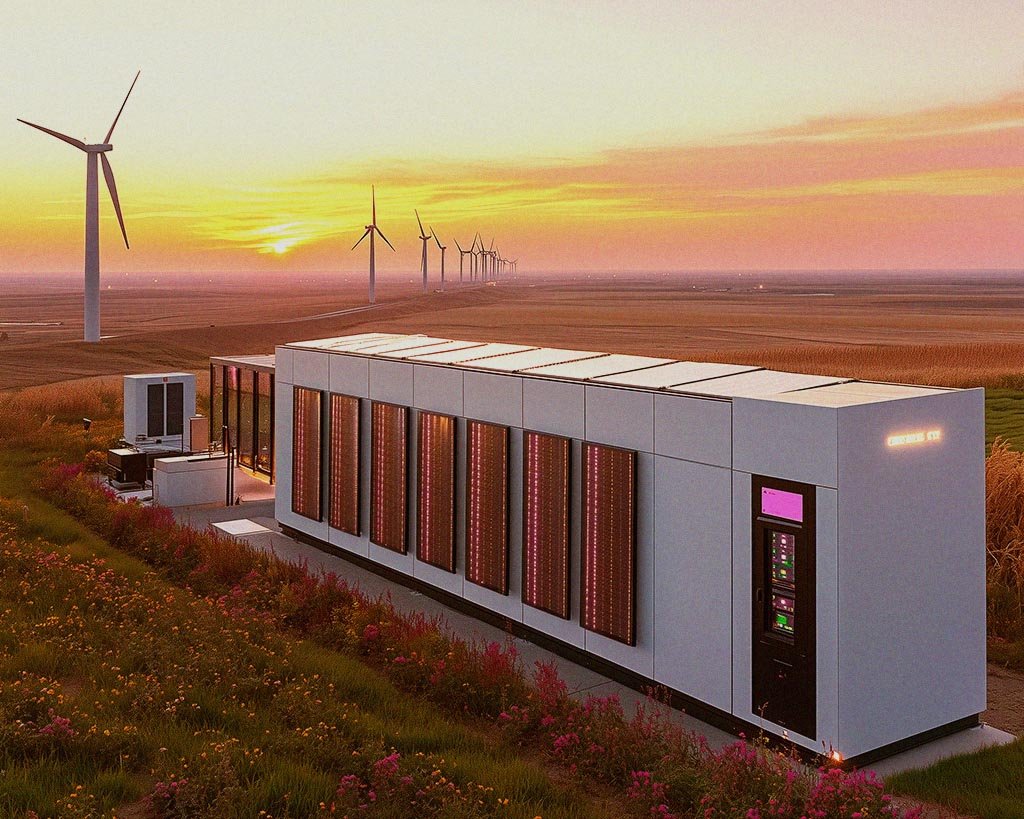What does Sustainable Energy Storage Mean?
Sustainable energy storage encompasses technologies and methods used to capture and store energy generated from renewable sources, such as solar and wind power, for later use when these sources are unavailable or intermittent. This framework includes various storage solutions, each with unique advantages and limitations, working together to create a reliable and resilient energy system.
Imagine a world powered by the sun and the wind, a future free from fossil fuels and the destructive forces of climate change. It’s a vision that’s tantalizingly close, but there’s a catch: the sun doesn’t always shine, and the wind doesn’t always blow. To truly unlock the potential of renewable energy, we need ingenious ways to store its power for those moments when nature takes a break.
The current limitations of energy storage are like trying to fill a bathtub with a leaky bucket – we’re generating clean energy, but much of it is lost due to our inability to store it efficiently and effectively. This represents a significant roadblock to widespread adoption of renewables and achieving a sustainable energy future.
Key Ideas
This article delves into the fascinating world of sustainable energy storage, exploring the technologies that hold the key to unlocking a renewable-powered future. We’ll examine the challenges, celebrate the advancements, and analyze the economic factors driving this crucial aspect of the clean energy revolution. Get ready to explore the world of batteries, pumped hydro, and thermal storage, as we explore the ingenious solutions paving the way for a sustainable energy landscape.
Thesis Statement: The development and implementation of advanced and cost-effective energy storage solutions are critical for overcoming the intermittency challenges of renewable energy sources, paving the way for a future powered by clean, sustainable energy.
The Energy Storage Landscape: A Diverse Array of Solutions
The quest for effective energy storage has led to the development of a diverse range of technologies, each with its own unique strengths and limitations. These solutions, from the familiar batteries in our smartphones to the massive pumped hydro facilities powering entire cities, are paving the way for a sustainable energy future.
- Pumped Hydroelectric Storage (PHS): Think of it as a giant water battery. PHS uses excess electricity to pump water uphill to a reservoir, then releases the water downhill through turbines to generate electricity when demand is high. It’s a proven and mature technology, responsible for the majority of current energy storage capacity globally. [1]
- Fun Fact: The Bath County Pumped Storage Station in Virginia, USA, is the world’s largest PHS facility, with a capacity of over 3,000 MW!
- Lithium-ion Batteries: The same technology that powers your phone is increasingly used for grid-scale energy storage. Lithium-ion batteries are known for their high energy density, fast response times, and declining costs, making them an attractive option for various applications, including electric vehicles and home energy storage. [2]
- Redox Flow Batteries: These batteries store energy in liquid electrolytes, offering advantages in terms of scalability and lifespan. They are particularly well-suited for long-duration energy storage applications. [3]
- Compressed Air Energy Storage (CAES): This technology uses excess electricity to compress air into underground caverns or tanks, then releases the compressed air to drive turbines and generate electricity when needed. CAES can provide large-scale, long-duration storage. [4]
- Thermal Energy Storage (TES): TES systems store energy in the form of heat or cold, using materials like molten salt or ice. TES can be used for various applications, including heating and cooling buildings and industrial processes. [5]
- Flywheels: These mechanical devices store energy in the form of rotational kinetic energy. Flywheels offer high power output and fast response times, making them suitable for short-duration grid stabilization applications. [6]
- Hydrogen Storage: Hydrogen can be produced from renewable energy sources through electrolysis and stored for later use as a fuel or converted back to electricity through fuel cells. Hydrogen offers potential for long-duration storage and diverse applications, including transportation and industrial processes. [7]
The energy storage landscape is constantly evolving, with ongoing research and development leading to improvements in existing technologies and the emergence of new and innovative solutions.
The Cost of Energy Storage: Balancing Performance and Affordability
As the clean energy transition accelerates, the cost of energy storage becomes a crucial factor in determining the viability and widespread adoption of renewable energy technologies. Finding the sweet spot between performance and affordability is key to unlocking a sustainable energy future.
- The Cost Curve is Trending Downwards: The cost of energy storage, particularly for batteries, has decreased dramatically in recent years, driven by advances in technology, economies of scale, and increased competition. This trend is expected to continue, making energy storage increasingly affordable and competitive with traditional fossil fuel-based power plants. [8]
- Cost Varies by Technology: The cost of energy storage varies significantly depending on the technology used, its capacity, and its intended application. Pumped hydro remains the most cost-effective solution for large-scale, long-duration storage, while batteries are becoming increasingly competitive for shorter-duration applications.
- The Levelized Cost of Storage (LCOS): This metric helps compare the cost-effectiveness of different energy storage technologies by calculating the total cost of ownership and operation over the lifetime of the system. LCOS takes into account factors like capital costs, operating expenses, and the system’s efficiency and lifespan.
- Cost Reduction is Key to Wider Adoption: Further cost reductions in energy storage are critical for accelerating the adoption of renewable energy and creating a more resilient and sustainable grid. Continued research and development, as well as supportive policies, are essential to drive down costs and unlock the full potential of energy storage.
The Future of Energy Storage: A Symphony of Innovation
The future of energy storage is brimming with exciting possibilities, driven by a symphony of innovation in materials science, chemistry, and engineering. These advancements promise to create even more efficient, cost-effective, and sustainable energy storage solutions, paving the way for a cleaner and more resilient energy future.
- Advanced Battery Technologies: Researchers are exploring a range of next-generation battery chemistries, including solid-state batteries, sodium-ion batteries, and metal-air batteries. These technologies have the potential to offer higher energy density, longer lifespan, improved safety, and lower costs compared to existing lithium-ion batteries. [9]
- Grid-Scale Energy Storage Innovations: Innovations in grid-scale energy storage are focusing on increasing capacity, improving efficiency, and developing hybrid storage solutions that combine different technologies to optimize performance and cost.
- Smart Grid Integration: Integrating energy storage systems with smart grids can enhance grid stability, optimize energy dispatch, and improve the reliability of renewable energy sources. Smart grids enable real-time monitoring and control of energy flow, enabling more efficient use of storage resources. [10]
- Decentralized Energy Storage: Distributed energy storage solutions, like residential battery systems and community-level microgrids, are gaining traction, increasing grid resilience, empowering consumers, and reducing reliance on centralized power plants.
- The Role of Artificial Intelligence (AI): AI is playing an increasingly important role in optimizing energy storage systems, predicting energy demand, improving battery management, and enhancing the overall efficiency of renewable energy grids. [11]
What Next?
The quest for better ways to store energy is not merely a technological pursuit; it’s a necessity for creating a sustainable and secure energy future. As we strive to transition away from fossil fuels and embrace renewable energy sources, the ability to store the sun’s energy and harness the power of the wind, even when they’re not readily available, becomes paramount.
The advancements in energy storage technologies, combined with declining costs and ongoing research and development, paint an optimistic picture. We’re on the cusp of a revolution in how we generate, store, and consume energy. A future powered by clean, sustainable, and reliable energy sources is within reach.
Additional Thoughts
- The intermittency of renewable energy sources like solar and wind power necessitates the development and implementation of effective energy storage solutions.
- A diverse array of energy storage technologies is available, including pumped hydro, batteries, thermal storage, and compressed air storage, each with its own advantages and limitations.
- The cost of energy storage has been decreasing significantly, making it increasingly competitive with traditional fossil fuel-based power generation.
- Ongoing research and development are focused on improving existing technologies, developing innovative solutions, and integrating energy storage systems into smart grids for optimized energy management.
- The wider adoption of energy storage is critical for achieving a sustainable energy future, ensuring grid reliability, and unlocking the full potential of renewable energy resources.
The journey towards a sustainable energy future is a collective effort. It requires collaboration between scientists, engineers, policymakers, businesses, and individuals. By embracing innovation, supporting research, and implementing forward-thinking policies, we can power our world with clean energy and create a brighter future for generations to come.
Let’s embrace the challenge, celebrate the progress, and work together to unlock the full potential of sustainable energy storage – because the power to create a sustainable future is within our grasp.
References
[1] International Hydropower Association. (2023). Pumped Hydropower.
[2] U.S. Department of Energy. (2023). Energy Storage Basics – Batteries.
[3] U.S. Department of Energy. (2023). Energy Storage Basics – Flow Batteries.
[4] U.S. Department of Energy. (2023). Energy Storage Basics – Compressed Air Energy Storage.
[5] U.S. Department of Energy. (2023). Energy Storage Basics – Thermal Energy Storage.
[6] U.S. Department of Energy. (2023). Energy Storage Basics – Flywheels.
[7] U.S. Department of Energy. (2023). Hydrogen Storage.
[8] BloombergNEF. (2023). New Energy Outlook 2023.
[9] International Energy Agency. (2022). Energy Storage Technology Brief.
[10] U.S. Department of Energy. (2023). Smart Grid.
[11] Luo, X., Wang, J., Dooner, M., & Clarke, J. (2015). Overview of current development in electrical energy storage technologies and the application potential in smart grids. Applied Energy, 137, 511-536.





















+ There are no comments
Add yours